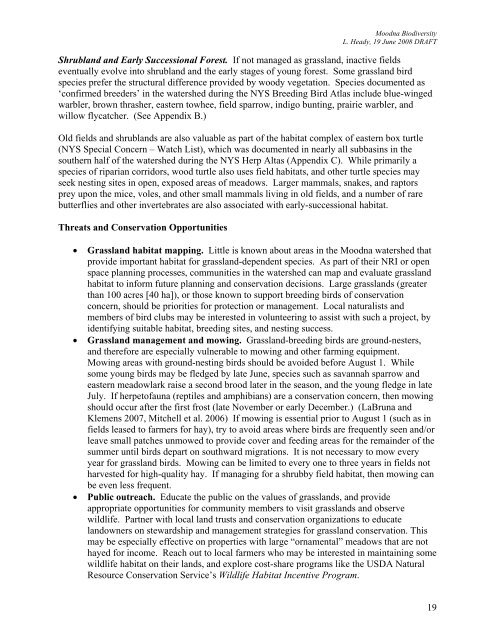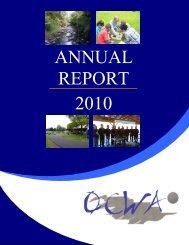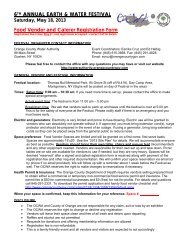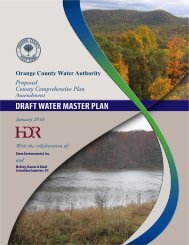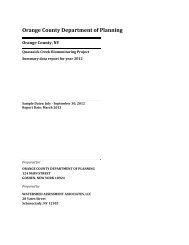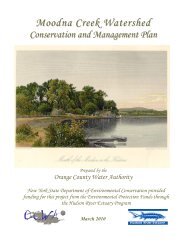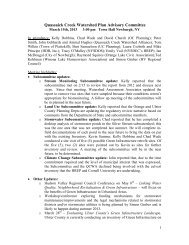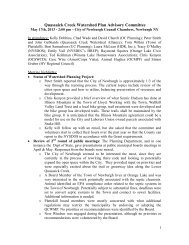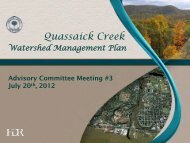Biodiversity of the Moodna Creek Watershed - Orange County Water ...
Biodiversity of the Moodna Creek Watershed - Orange County Water ...
Biodiversity of the Moodna Creek Watershed - Orange County Water ...
You also want an ePaper? Increase the reach of your titles
YUMPU automatically turns print PDFs into web optimized ePapers that Google loves.
<strong>Moodna</strong> <strong>Biodiversity</strong><br />
L. Heady, 19 June 2008 DRAFT<br />
Shrubland and Early Successional Forest. If not managed as grassland, inactive fields<br />
eventually evolve into shrubland and <strong>the</strong> early stages <strong>of</strong> young forest. Some grassland bird<br />
species prefer <strong>the</strong> structural difference provided by woody vegetation. Species documented as<br />
‘confirmed breeders’ in <strong>the</strong> watershed during <strong>the</strong> NYS Breeding Bird Atlas include blue-winged<br />
warbler, brown thrasher, eastern towhee, field sparrow, indigo bunting, prairie warbler, and<br />
willow flycatcher. (See Appendix B.)<br />
Old fields and shrublands are also valuable as part <strong>of</strong> <strong>the</strong> habitat complex <strong>of</strong> eastern box turtle<br />
(NYS Special Concern – Watch List), which was documented in nearly all subbasins in <strong>the</strong><br />
sou<strong>the</strong>rn half <strong>of</strong> <strong>the</strong> watershed during <strong>the</strong> NYS Herp Altas (Appendix C). While primarily a<br />
species <strong>of</strong> riparian corridors, wood turtle also uses field habitats, and o<strong>the</strong>r turtle species may<br />
seek nesting sites in open, exposed areas <strong>of</strong> meadows. Larger mammals, snakes, and raptors<br />
prey upon <strong>the</strong> mice, voles, and o<strong>the</strong>r small mammals living in old fields, and a number <strong>of</strong> rare<br />
butterflies and o<strong>the</strong>r invertebrates are also associated with early-successional habitat.<br />
Threats and Conservation Opportunities<br />
• Grassland habitat mapping. Little is known about areas in <strong>the</strong> <strong>Moodna</strong> watershed that<br />
provide important habitat for grassland-dependent species. As part <strong>of</strong> <strong>the</strong>ir NRI or open<br />
space planning processes, communities in <strong>the</strong> watershed can map and evaluate grassland<br />
habitat to inform future planning and conservation decisions. Large grasslands (greater<br />
than 100 acres [40 ha]), or those known to support breeding birds <strong>of</strong> conservation<br />
concern, should be priorities for protection or management. Local naturalists and<br />
members <strong>of</strong> bird clubs may be interested in volunteering to assist with such a project, by<br />
identifying suitable habitat, breeding sites, and nesting success.<br />
• Grassland management and mowing. Grassland-breeding birds are ground-nesters,<br />
and <strong>the</strong>refore are especially vulnerable to mowing and o<strong>the</strong>r farming equipment.<br />
Mowing areas with ground-nesting birds should be avoided before August 1. While<br />
some young birds may be fledged by late June, species such as savannah sparrow and<br />
eastern meadowlark raise a second brood later in <strong>the</strong> season, and <strong>the</strong> young fledge in late<br />
July. If herpet<strong>of</strong>auna (reptiles and amphibians) are a conservation concern, <strong>the</strong>n mowing<br />
should occur after <strong>the</strong> first frost (late November or early December.) (LaBruna and<br />
Klemens 2007, Mitchell et al. 2006) If mowing is essential prior to August 1 (such as in<br />
fields leased to farmers for hay), try to avoid areas where birds are frequently seen and/or<br />
leave small patches unmowed to provide cover and feeding areas for <strong>the</strong> remainder <strong>of</strong> <strong>the</strong><br />
summer until birds depart on southward migrations. It is not necessary to mow every<br />
year for grassland birds. Mowing can be limited to every one to three years in fields not<br />
harvested for high-quality hay. If managing for a shrubby field habitat, <strong>the</strong>n mowing can<br />
be even less frequent.<br />
• Public outreach. Educate <strong>the</strong> public on <strong>the</strong> values <strong>of</strong> grasslands, and provide<br />
appropriate opportunities for community members to visit grasslands and observe<br />
wildlife. Partner with local land trusts and conservation organizations to educate<br />
landowners on stewardship and management strategies for grassland conservation. This<br />
may be especially effective on properties with large “ornamental” meadows that are not<br />
hayed for income. Reach out to local farmers who may be interested in maintaining some<br />
wildlife habitat on <strong>the</strong>ir lands, and explore cost-share programs like <strong>the</strong> USDA Natural<br />
Resource Conservation Service’s Wildlife Habitat Incentive Program.<br />
19


